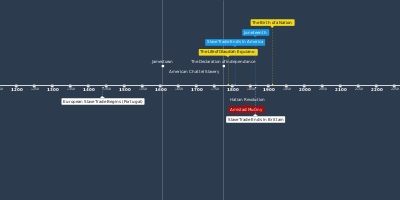2 Jul 1822 Jahr - Denmark Vesey Hanged
Beschreibung:
Even after gaining his freedom, Vesey continued to identify and socialize with many slaves. He became increasingly set on helping his new friends break from the bonds of slavery. In the year of 1821, Vesey and a few slaves began to conspire and plan a revolt. Vesey held numerous secret meetings and eventually gained the support of both slaves and free blacks throughout the city and countryside who were willing to fight for their freedom. He was said to organize thousands of slaves who pledged to participate in his planned insurrection.His plan was first, to make a coordinated attack on the Charleston Meeting Street Arsenal. Once they secured these weapons, these Freedom Fighters planned to commandeer ships from the harbor and sail to Haiti, possibly with Haitian help. Vesey and his followers also planned to kill white slaveholders throughout the city, as had been done in Haiti, and liberate the slaves. According to records of the French Consulate in Charleston, his group was reported to have numerous members who were "French Negroes," slaves brought from Saint-Domingue by refugee masters.
Due to the vast number of slaves who knew about the planned uprising, Vesey feared that word of the plot would get out. Vesey reportedly advanced the date of the insurrection to June 16.[16] Beginning in May, two slaves opposed to Vesey's scheme, George Wilson and Joe LaRoche, gave the first specific testimony about a coming uprising to Charleston officials, saying a "rising" was planned for July 14. Mayor James Hamilton was told, and he organized a citizens' militia, putting the city on alert. White militias and groups of armed men patrolled the streets daily for weeks until many suspects were arrested by the end of June, including 55-year-old Denmark Vesey.
In total, the courts convicted 67 men of conspiracy and hanged 35, including Vesey, in July 1822. A total of 31 men were deported, 27 reviewed and acquitted, and 38 questioned and released.
In August both Governor Bennett and Mayor Hamilton published accounts of the insurrection and Court proceedings. Hamilton attributed the insurrection to the influence of black Christianity and the AME African Church, an increase in slave literacy, and misguided paternalism by masters toward slaves. In October the Court issued its Report, shaped by Hamilton.
Lacy K. Ford notes that:
the most important fact about the Report was (and remains) that it tells the story that Hamilton and the Court wanted told. It shaped the public perception of events, and it was certainly intended to do just that. As such, it makes important points about the Vesey Court’s agenda, regardless of the larger historical truth of the document’s claims about the alleged insurrection and accused insurrectionists.
Zugefügt zum Band der Zeit:
Datum:
2 Jul 1822 Jahr
Jetzt
~ 203 years ago
